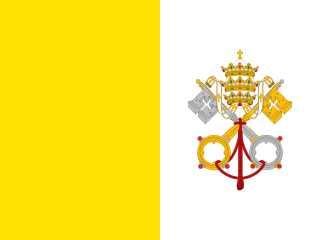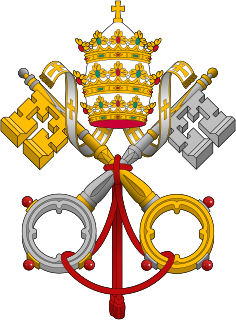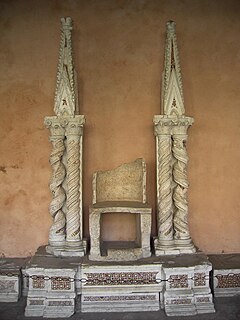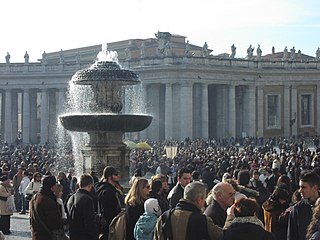
The First Vatican Council was convoked by Pope Pius IX on 29 June 1868, after a period of planning and preparation that began on 6 December 1864. This, the twentieth ecumenical council of the Catholic Church, held three centuries after the Council of Trent, opened on 8 December 1869 and adjourned on 20 October 1870. Unlike the five earlier general councils held in Rome, which met in the Lateran Basilica and are known as Lateran councils, it met in the Vatican Basilica, hence its name. Its best-known decision is its definition of papal infallibility.

The Vatican City State is a neutral nation, which has not engaged in any war since its formation in 1929 by the Lateran Treaty. It has no formal military compact or agreement with neighbouring Italy, although responsibility for defending the Vatican City from an international aggressor is likely to lie primarily with the Italian Armed Forces. Although the Vatican City State has never been at war, its forces were exposed to military aggression when it was bombed during World War II, and whilst defending Vatican property in Rome during the same conflict.

The Papal States, officially the State of the Church, were a series of territories in the Italian Peninsula under the direct sovereign rule of the Pope, from the 8th century until 1870. They were among the major states of Italy from roughly the 8th century until the Kingdom of Piedmont-Sardinia unified the Italian Peninsula by conquest in a campaign virtually concluded in 1861 and definitively in 1870. At their zenith, the Papal States covered most of the modern Italian regions of Lazio, Marche, Umbria and Romagna, and portions of Emilia. These holdings were considered to be a manifestation of the temporal power of the pope, as opposed to his ecclesiastical primacy.

The papal tiara is a crown that was worn by popes of the Catholic Church from as early as the 8th century to the mid-20th. It was last used by Pope Paul VI in 1963 and only at the beginning of his reign.

A papal coronation was the ceremony of the placing of the papal tiara on a newly elected pope. The first recorded papal coronation was that of Nicholas I in 858. The last was the 1963 coronation of Paul VI, who soon afterwards abandoned the practice of wearing the tiara. None of his successors have used the tiara, and their papal inauguration celebrations have included no coronation ceremony.

The Apostolic Palace is the official residence of the pope, the head of the Catholic Church, located in Vatican City. It is also known as the Papal Palace, the Palace of the Vatican and the Vatican Palace. The Vatican itself refers to the building as the Palace of Sixtus V, in honor of Pope Sixtus V, who built most of the present form of the palace.

Papal regalia and insignia are the official items of attire and decoration proper to the Pope in his capacity as the head of the Roman Catholic Church and sovereign of the Vatican City State.

The funeral of Pope John Paul II was held on 8 April 2005, six days after his death on 2 April. The funeral was followed by the novemdiales devotional in which the Catholic Church observes nine days of mourning.

The Noble Guard was one of the household guard units serving the Pope. It was formed by Pope Pius VII in 1801 as a regiment of heavy cavalry. Conceived as the Pope's personal guard, the unit provided a mounted escort for the Pope when he moved about Rome in his carriage and mounted guard outside his apartments in the papal palaces. The guardsmen were also available for special missions within the Papal States at the behest of the pope. One of their first major duties was to escort Pius VII to Paris for the Coronation of Napoleon I in 1804.

The Palatine Guard was a military unit of the Vatican. It was formed in 1850 by Pope Pius IX, who ordered that the two militia units of the Papal States be amalgamated. The corps was formed as an infantry unit, and took part in watch-keeping in Rome. The only occasion on which it saw active service was during the token resistance on 20 September 1870 to the occupation of Rome by Italian government troops.

The history of the papacy, the office held by the pope as head of the Roman Catholic Church, according to Catholic doctrine, spans from the time of Peter to the present day.

A major basilica is one of the four highest-ranking Roman Catholic church buildings, all of which are also papal basilicas: the Archbasilica of St. John Lateran, St. Peter's Basilica, the Basilica of St. Paul Outside the Walls, and the Basilica di Santa Maria Maggiore. All of them are located within the diocese of Rome: St. Peter's Basilica is located in Vatican City and thus within the territory and sovereign jurisdiction of the Holy See. The other three are geographically located in Italian territory, but enjoy extraterritorial status under the Lateran Treaty. The Archbasilica of St. John in the Lateran is the seat of the Pope and the site of the Papal Cathedra, and is the oldest and first in rank of the major basilicas.

The black nobility or black aristocracy are Roman aristocratic families who sided with the Papacy under Pope Pius IX after the Savoy family-led army of the Kingdom of Italy entered Rome on 20 September 1870, overthrew the Pope and the Papal States, and took over the Quirinal Palace, and any nobles subsequently ennobled by the Pope prior to the 1929 Lateran Treaty.
The Gendarmerie Corps of Vatican City State is the gendarmerie, or police and security force, of Vatican City and the extraterritorial properties of the Holy See.

The Pontifical Swiss Guard is a small force maintained by the Holy See that is responsible for the safety of the Pope, including the security of the Apostolic Palace. The Swiss Guard serves as the de facto military of Vatican City. Established in 1506 under Pope Julius II, the Pontifical Swiss Guard is among the oldest military units in continuous operation.
This is an index of Vatican City-related topics.

The apostolic letter motu proprioPontificalis Domus was issued by Pope Paul VI on 28 March 1968, in the fifth year of his pontificate. It reorganized the Papal Household, which had been known until then as the Papal Court.

The orders, decorations, and medals of the Holy See include titles, chivalric orders, distinctions and medals honoured by the Holy See, with the Pope as the fount of honour, for deeds and merits of their recipients to the benefit of the Holy See, the Catholic Church, or their respective communities, societies, nations and the world at large.

The Vatican Historical Museum is one of the sections of the Vatican Museums. It was founded in 1973 at the behest of Pope Paul VI, and was initially hosted in environments under the Square Garden. In 1987 it was moved to the main floor of the Apostolic Palace of the Lateran and opened in March 1991.




















